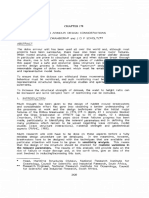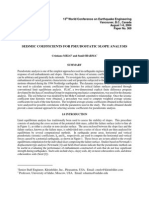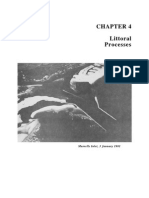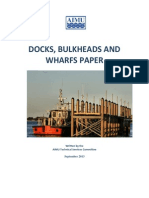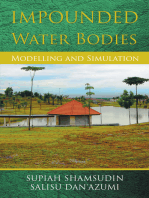Revements, Seawalls and Bulkheads, Part 1
Revements, Seawalls and Bulkheads, Part 1
Uploaded by
Bung Ma'rufCopyright:
Available Formats
Revements, Seawalls and Bulkheads, Part 1
Revements, Seawalls and Bulkheads, Part 1
Uploaded by
Bung Ma'rufCopyright
Available Formats
Share this document
Did you find this document useful?
Is this content inappropriate?
Copyright:
Available Formats
Revements, Seawalls and Bulkheads, Part 1
Revements, Seawalls and Bulkheads, Part 1
Uploaded by
Bung Ma'rufCopyright:
Available Formats
Design of Revetments, Seawalls and Bulkheads
Ref: Shore Protection Manual, USACE, 1984
EM 1110-2-1614, Design of Revetments, Seawalls and Bulkheads, USACE, 1995
Breakwaters, Jetties, Bulkheads and Seawalls, Pile Buck, 1992
Coastal, Estuarial and Harbour Engineers' Reference Book, M.B. Abbot and W.A. Price,
1994, (Chapter 27)
Topics
Definitions and Descriptions of Bank Protection and Earth Retention Structures
Design Considerations
Shoreline Use
Shoreline Form and Composition
Seasonal Variations of Shoreline Profiles
Conditions for Protective Measures
Design Water Levels
Design Wave Estimation, Wave Height and Stability Considerations
Breaking Waves
Height of Protection; Wave Runup & Overtopping
Stability and Flexibility
Bulkhead Line
Equations for Armoring and Riprap
Reserve Stability
Toe Protection
Filters
Flank Protection
Material Hazards and Problems
------------------------------------------------------------------------------------------------------------------
---
Definitions and Descriptions of Bank Protection and Earth Retention Structures
Bank protection and earth retention structures differ from breakwaters mainly in that they
are constructed against land. Therefore, the earth pressure is a main design concern. These
structures could be vertical, such as bulkheads, or sloped, such as revetment, levees and dikes.
Seawalls may be vertical, but may also be curved, sloped or stepped.
Seawall
massive structure
primarily designed to resist wave action along high value coastal property
either gravity- or pile-supported structures
concrete or stone.
variety of face shapes (figures 1)
1
Curved Face - designed to accommodate the impact and runup of large waves
while directing the flow away from the land being protected. Flow strikes the wall
forced along the curving face falls harmlessly back to the ground, or it is
recurved to splash back seaward. Large wave forces must be resisted and
redirected. This requires a massive structure with an adequate foundation and
sturdy toe protection.
Stepped Face - designed to limit wave runup and overtopping. They are generally
less massive than curved-face seawalls, but the general design requirements for
structural stability are the same for this kind of structure.
Combination - incorporates the advantages of both curved and stepped face
seawalls.
Rubble - essentially a rubble breakwater that is placed directly on the beach. The
rough surface tends to absorb and dissipate wave energy with a minimum of wave
reflection and scour.
Figure 1, Seawall Alternatives
2
Revetment
facing of erosion resistant material, such as stone or concrete
built to protect a scarp, embankment, or other shoreline feature against erosion
major components: armor layer, filter, and toe (see figure 2)
armor layer provides the basic protection against wave action
filter layer supports the armor, allows water to pass through the structure and prevents
the underlying soil from being washed through the armor
toe protection prevents displacement of the seaward edge of the revetment
Figure 2, Typical revetment
Bulkheads
retaining walls which hold or prevent backfill from sliding
provide protection against light-to-moderate wave action
used to protect eroding bluffs by retaining soil at the toe and increasing stability, or by
protecting the toe from erosion and undercutting
used for reclamation projects, where a fill is needed seaward of the existing shore
used in marinas and other structures where deep water is needed directly at the shore.
Figure 3, Sheet-pile bulkhead
3
Design Considerations (excerpts from EM 1110-2-1614, USACE, 1995)
A. Shoreline Use
Some structures are better suited than others for particular shoreline uses. Revetments of
randomly placed stone may hinder access to a beach, while smooth revetments built with concrete
blocks generally present little difficulty for walkers. Seawalls and bulkheads can also create an
access problem that may require the building of stairs. Bulkheads are required, however, where
some depth of water is needed directly at the shore, such as for use by boaters.
B. Shoreline Form and Composition
1. Bluff shorelines.
Bluff shorelines that are composed of cohesive or granular materials may fail because of
scour at the toe or because of slope instabilities aggravated by poor drainage conditions,
infiltration, and reduction of effective stresses due to seepage forces. Cantilevered or anchored
bulkheads can protect against toe scour and, being embedded, can be used under some
conditions to prevent sliding along subsurface critical failure planes. The most obvious limiting
factor is the height of the bluff, which determines the magnitude of the earth pressures that
must be resisted, and, to some extent, the depth of the critical failure surface. Care must be
taken in design to ascertain the relative importance of toe scour and other factors leading to
slope instability. Gravity bulkheads and seawalls can provide toe protection for bluffs but have
limited applicability where other slope stability problems are present. Exceptions occur in cases
where full height retention is provided for low bluffs and where the retained soil behind a
bulkhead at the toe of a higher bluff can provide sufficient weight to help counter-balance the
active thrust of the bluff materials.
2. Beach shorelines.
Revetments, seawalls, and bulkheads can all be used to protect backshore developments
along beach shorelines. An important consideration is whether wave reflections may erode the
fronting beach (i.e. sloped faces absorb more wave energy than vertical walls).
C. Seasonal Variations of Shoreline Profiles
Beach recession in winter and growth in summer can be estimated by periodic site
inspections and by computed variations in seasonal beach profiles. The extent of winter beach
profile lowering will be a contributing factor in determining the type and extent of needed toe
protection.
D. Conditions for Protective Measures
Structures must withstand the greatest conditions for which damage prevention is claimed
in the project plan. All elements must perform satisfactorily (no damage exceeding ordinary
maintenance) up to this condition, or it must be shown that an appropriate allowance has been
made for deterioration (damage prevention adjusted accordingly and rehabilitation costs mortised
if indicated). As a minimum, the design must successfully withstand conditions which have a 50
percent probability of being exceeded during the projects economic life. In addition, failure of the
project during probable maximum conditions should not result in a catastrophe (i.e. loss of life or
inordinate loss of property/money).
E. Design Water Levels
The maximum water level is needed to estimate the maximum breaking wave height at the
structure, the amount of runup to be expected, and the required crest elevation of the structure.
4
Minimum expected water levels play an important role in anticipating the amount of toe scour that
may occur and the depth to which the armor layer should extend. Consideration are:
1. Astronomical tides
2. Wind setup and pressure effects
3. Storm surge
4. Lake level effects, including regulatory works controls
F. Design Wave Estimation, Wave Height and Stability Considerations
Wave heights and periods should be chosen to produce the most critical combination of
forces on a structure with due consideration of the economic life, structural integrity and hazard
for events that may exceed the design conditions. Wave characteristics may be based on an
analysis of wave gauge records, visual observations of wave action, published wave hindcasts,
wave forecasts or the maximum breaking wave at the site. Wave characteristics derived from such
methods may be for deepwater locations and must be transformed to the structure site using
refraction and diffraction techniques as described in the SPM. Wave analyses may have to be
performed for extreme high and low design water levels and for one or more intermediate levels
to determine the critical design conditions.
Available wave information is frequently given as the energy-based height of the zeroth
moment, H
mo
. In deep water, H
s
and H
mo
are about equal; however, they may be significantly
different in shallow water due to shoaling (Thompson and Vincent 1985). The following equation
may be used to equate H
s
from energy-based wave parameters (Hughes and Borgman 1987):
1
1
]
1
,
_
1
2
exp
c
p
s
o
mo
s
gT
d
c
H
H
,
where T
p
is the period of the peak energy density of the wave spectrum and c
o
and c
1
are
regression coefficients equal to 0.00089 and 0.834, respectively. described in the SPM. A
conservative value of Hs may be obtained by using 0.00136 for c
o
, which gives a reasonable upper
envelope for the data in Hughes and Borgman.
This equation should not be used when
0005 . 0
2
<
p
gT d
or there is substantial breaking.
In shallow water, H
s
is estimated from deepwater conditions using the irregular wave shoaling and
breaking model of Goda (1975, 1985) which is available as part of the Automated Coastal
Engineering System (ACES) package (Leenknecht et al. 1989). Goda (1985) recommends for the
design of rubble structures that if the depth is less than one-half the deepwater significant wave
height, then design should be based on the significant wave height at a depth equal to one-half the
significant deepwater wave height.
Wave period for spectral wave conditions is typically given as period of the peak energy
density of the spectrum, T
p
. However, it is not uncommon to find references and design formulae
based on the average wave period or the significant wave period.
The wave height to be used for stability considerations depends on whether the structure
is rigid, semirigid, or flexible. Rigid structures that could fail catastrophically if overstressed may
warrant design based on H
1
. Semi-rigid structures may warrant a design wave between H
1
and
H
10
.. Flexible structures are usually designed for H
s
or H
10
. Stability coefficients are coupled with
these wave heights to develop various degrees of damage, including no damage.
5
Available wave gauge and visual observation data for use by designers is often sparse and
limited to specific sites. In addition, existing gauge data are sometimes analog records which have
not been analyzed and that are difficult to process. Project funding and time constraints may
prohibit the establishment of a viable gauging program that would provide sufficient digital data
for reliable study. Visual observations from shoreline points are convenient and inexpensive, but
they have questionable accuracy, are often skewed by the omission of extreme events, and are
sometimes difficult to extrapolate to other sites along the coast.
For wave hindcasts and forecasts, designers should use the simple methods in ACES
(Leenknecht et al. 1989) and hindcasts developed by the U.S. Army Engineer Waterways
Experiment Sta-tion (WES) (Resio and Vincent 1976-1978; Corson et al. 1981) for U.S. coastal
waters using numerical models. These later results are presented in a series of tables for each of
the U.S. coasts. They give wave heights and periods as a function of season, direction of wave
approach, and return period; wave height as a function of return period and seasons combined;
and wave period as a function of wave height and approach angle. Several other models exist for
either shallow or deep water.
G. Breaking Waves
Wave heights derived from a hindcast should be checked against the maximum breaking
wave that can be supported at the site given the available depth at the design still-water level and
the nearshore bottom slope. Design wave heights will be the smaller of the maximum breaker
height or the hindcast wave height.
For the severe conditions commonly used for design, H
mo
may be limited by breaking wave
conditions. A reasonable upper bound for H
mo
is given by
( ) ( ) h k L H
p p mo
tanh 10 . 0
max
, where L
p
and k
p
are the wave length and wave number
determined for T
p
and at depth h.
H. Height of Protection
When selecting the height of protection, one must consider the maximum water level, any
anticipated structure settlement, freeboard, and wave runup and overtopping.
Elevation of the structure is perhaps the single most important controlling design factor
and is also critical to the performance of the structure. Numerous seawall failures can be directly
and indirectly attributed to inadequate elevations.
Elevation with reference to mean lower low water (MLLW) is determined by the
following equation:
F + H + + + =
h w s t e
t
= spring tidal range.
s
= design storm surge.
w
= wave setup.
H = design wave height.
F = freeboard.
The MLLW level is a local property and varies from location to location with reference to
the chart datum. In the United States the US Geodetic datum, known as NGVD is the standard.
Around other parts of the world the datum are different. It is important to obtain such datums
from the local government.
6
Scouring depth
S
D
Dredge line
Chart Datum
MLLW
t
Mean high spring tide
Storm surge
w
Wave set-up
Reflected wave height
H
Freeboard
F
h
e
Note from the diagram that below MLLW, the chart datum, dredge level and scour depth
must be considered. In addition, settlement may be important.
Sometimes for practical reasons, the elevation is set below the calculated design value and
wave overtopping will occur during a storm. Under this condition, the designer must understand
the effects and consequences of allowing overtopping and make adequate provisions to counter
these effects and consequences. This often means partial or total loss of structures supported by
the upland soil and partial or total loss of seawalls.
7
I. Wave Runup & Overtopping
Runup is the vertical height above the still-water level (SWL) to which the uprush from a
wave will rise on a structure. Note that it is not the distance measured along the inclined surface.
a. Rough slope runup. Maximum runup by irregular waves on riprap-covered revetments
may be estimated by (Ahrens and Heimbaugh 1988)
+
b
a
H
R
mo
1
max
, where R
max
is the maximum runup, a and b are regression coefficients
(1.022 and 0.24, respectively) and is the surf zone parameter found by 2
2
tan
p
mo
gT
H
,
where is the slope of the revetment.
A more conservative value for R
max
is obtained by using 1.286 for a in the equation.
Maximum runups determined using this more conservative value provide a reasonable upper limit
to the data from which the equation was developed.
Runup estimates for revetments covered with materials other than riprap may be obtained
with the rough slope correction factors in Table 1 (Table 2-2 in EM 1110-2-1614). Table 1 was
developed for earlier estimates of runup based on monochromatic wave data and smooth slopes.
To use the correction with the irregular wave rough slope runup estimates of the above equation,
multiply R
max
obtained from the equation for riprap by the correction factor listed in the table and
divide by the correction factor for quarry-stone. For example, to estimate R
max
for a stepped 1:1.5
slope with vertical risers, determine R
max
and multiply by (correction factor for stepped
slope/correction factor for quarrystone) (0.75/0.60) = 1.25. R
max
for the stepped slope is seen to
be 25 percent greater than for a riprap slope.
b. Smooth slope runup. Runup values for smooth slopes may be found in design curves in
the SPM. However, the smooth slope runup curves in the SPM were based on monochromatic
wave tests rather than more realistic irregular wave conditions. Using H
s
for wave height with the
design curves will yield runup estimates that may be exceeded by as much as 50 percent by waves
in the wave train with heights greater than H
s
. Maximum runup may be estimated by using the
rough slope equation and converting the estimate to smooth slope by dividing the result by the
quarrystone rough slope correction factor.
c. Runup on walls. Runup determinations for vertical and curved-face walls should be
made using the guidance given in the SPM.
8
Table 1 Rough Slope Runup Correction Factors (Carstea et al. 1975)
ArmorType
Slope
(cot )
RelativeSize
H/K
r
a,b
Correction Factor
r
Quarrystone 1.5 3 to 4 0.60
Quarrystone 2.5 3 to 4 0.63
Quarrystone 3.5 3 to 4 0.60
Quarrystone 5 3 0.60
Quarrystone 5 4 0.68
Quarrystone 5 5 0.72
Concrete Blocks
c
Any 6
b
0.93
Stepped slope with vertical risers 1.5
1 H
o
'/K
r
d
0.75
Stepped slope with vertical risers 2.0
1 H
o
'/K
r
d
0.75
Stepped slope with vertical risers 3.0
1 H
o
'/K
r
d
0.70
Stepped slope with rounded edges 3.0
1 H
o
'/K
r
d
0.86
Concrete Armor Units
Tetrapods random two layers 1.3 to 3.0 - 0.45
Tetrapods uniform two layers 1.3 to 3.0 - 0.51
Tribars random two layers 1.3 to 3.0 - 0.45
Tribars uniform one layer 1.3 to 3.0 - 0.50
a
K
r
is the characteristic height of the armor unit perpendicular to the slope. For quarrystone, it
is the nominal diameter; for armor units, the height above the slope.
b
Use H
o
' for d
s
/H
o
' > 3; and the local wave height, H
s
for d
s
/ H
o
' 3. (H
o
' is the unrefracted
deepwater wave height)
c
Perforated surfaces of Gobi Blocks, Monoslaps, and concrete masonry units placed hollows
up.
d
K
r
is the riser height.
d. Overtopping. It is generally preferable to design shore protection structures to be high
enough to preclude overtopping. In some cases, however, prohibitive costs or other
considerations may dictate lower structures than ideally needed. In those cases it may be
necessary to estimate the volume of water per unit time that may overtop the structure.
(1) Wave overtopping of riprap revetments may be estimated from the dimensionless
equation (Ward 1992)
( ) m C F C C
gH
Q
Q
o
mo
2 1
2
exp +
where non-dimensional freeboard, ( )
3 / 1
2
o mo
L H F F and F = structure freeboard
m
= cotangent of the revetment slope, cot
C
o
, C
1
, C
2
= regression coefficients equal to 0.4578, -29.45, 0.8464 respectively
The coefficients listed above were determined for dimensionless freeboards in the
range 0.25 < F' < 0.43, and revetment slopes of 1:2 and 1:3.5.
(2) Overtopping rates for seawalls are complicated by the numerous shapes found on the
seawall face plus the variety of fronting berms, revetments, and steps. Information on
9
overtopping rates for a range of configurations is available in Ward and Ahrens
(1992). For bulkheads and simple vertical seawalls with no fronting revetment and a
small parapet at the crest, the overtopping rate may be calculated from
,
_
+
s
o
mo
d
F
C F C C
gH
Q
2 1
2
exp
where d
s
= depth at structure toe and F' is defined above
C
o
, C
1
, C
2
= 0.338, -7.385, -2.178 respectively
For other configurations of seawalls, Ward and Ahrens (1992) should be
consulted, or physical model tests should be performed.
(alternate equations are contained in the Pile Buck Manual and SPM)
Since onshore winds increase the overtopping rate at a barrier. The overtopping rate may
be adjusted by multiplying a wind correction factor given by:
,
_
0.1 +
R
d
- h
W
+ 1.0 = k
s
f
sin
where W
f
is a coefficient depending on wind speed, and is the structure slope (90 deg. for a
vertical wall). For a wind speed of 60 mi/hr or greater, W
f
=2.0 should be used.
J. Stability and Flexibility
Structures can be built by using large monolithic masses that resist wave forces or by
using aggregations of smaller units that are placed either in a random or in a well-ordered array.
Examples of these are large reinforced concrete seawalls, quarrystone or riprap revetments, and
geometric concrete block revetments. The massive monoliths and interlocking blocks often exhibit
superior initial strength but, lacking flexibility, may not accommodate small amounts of
differential settlement or toe scour that may lead to premature failure. Randomly placed rock or
concrete armor units, on the other hand, experience settlement and readjustment under wave
attack, and, up to a point, have reserve strength over design conditions. They typically do not fail
catastrophically if minor damages are inflicted. Final design will usually require verification of
stability and performance by hydraulic model studies. For larger wave heights, model tests are
preferable to develop the optimum design.
J. Bulkhead Line
The Bulkhead Line is the position of the structure. Federal and state regulations and/or
local ordinances, sometimes, impose restrictions as to the location and the position of the
structures. Therefore, this line must be determined by the combined factors of:
a. Intended purposes.
b. Site characteristics.
c. Regulations.
10
Equations for Armoring and Riprap
1. Armor or riprap weight (Hudson's equation):
( )
cot 1
3
3
50
SG K
H
W
D
a
Stones within the cover layer can range from 0.75 to 1.25 W as long as 50 percent
weigh at least W and the gradation is uniform across the structures surface. The above
equation can be used for preliminary and final design when H is less than 5 ft and there is
no major overtopping of the structure. For larger wave heights, model tests are preferable
to develop the optimum design. The equation is for monochromatic waves and calculated
armor weights should be verified during model tests using spectral wave conditions.
2. Layer thickness:
3 / 1
,
_
a
W
nk r , typically n = 2
3. Armor units per surface area:
3 / 2
100
1
,
_
,
_
W
P
nk
A
N
a
a
4. Graded riprap layer thickness. The layer thickness for graded riprap must be
at least twice the nominal diameter of the W
50
stone ( ( )
3 / 1
W D )
at least 25 percent greater than the nominal diameter of the largest stone
and should always be greater than a minimum layer thickness of 1 ft (Ahrens 1975).
1
1
]
1
,
_
,
_
ft
W W
r
r r
1 , 25 . 1 , 0 . 2 max
3 / 1
100
3 / 1
min 50
min
where r
min
is the minimum layer thickness perpendicular to the slope.
Greater layer thickness' will tend to increase the reserve strength of the revetment against
waves greater than the design. Gradation (within broad limits) appears to have little effect on
stability provided the W
50
size is used to characterize the layer. The following are suggested
guidelines for establishing gradation limits (from EM 1110-2-1601) (see also Ahrens 1981):
(1) The lower limit of W
50
stone (W
50min
) should be selected based on stability requirements
using Hudson's equation.
(2) The upper limit of the W
100
stone (W
100max
) should equal the maximum size that can be
economically obtained from the quarry but not exceed 4 times W
50min
.
(3) The lower limit of the W
100
stone (W
100min
) should not be less than twice W
50min
.
(4) The upper limit of the W
50
stone (W
50max
) should be about 1.5 times W
50min
.
(5) The lower limit of the W
15
stone (W
15min
) should be about 0.4 times W
50min
.
(6) The upper limit of the W
15
stone (W
15max
) should be selected based on filter requirements
specified in EM1110-2-1901. It should slightly exceed W
50min
.
11
Reserve Stability
A well-known quality of randomly placed rubble structures is the ability to adjust and
resettle under wave conditions that cause minor damages. This has been called reserve strength or
reserve stability. Structures built of regular or uniformly placed units such as concrete blocks
commonly have little or no reserve stability and may fail rapidly if submitted to greater than design
conditions.
Values for the stability coefficient, K
D
, allow up to 5 percent damages under design wave
conditions. If the armor stone available at a site is lighter than the stone size calculated using the
wave height at the site, the zero-damage wave height for the available stone can be calculated,
and a ratio with the sites wave height can be used to estimate the damage that can be expected
with the available stone. The H/H
D=0
values found in the SPM are for breakwater design and non-
breaking wave conditions and include damage levels above 30 percent. Due to differences in the
form of damage to breakwaters and revetments, revetments may fail before damages reach 30
percent. The values should be used with caution for damage levels from breaking and non-
breaking waves.
Information on riprap reserve stability can be found in Ahrens (1981). Reserve stability
appears to be primarily related to the layer thickness although the median stone weight and
structure slope are also important.
Toe Protection
Toe protection is supplemental armoring of the beach or bottom surface in front of a
structure which prevents waves from scouring and under-cutting it. Factors that affect the severity
of toe scour include wave breaking (when near the toe), wave runup and backwash, wave
reflection, and grain-size distribution of the beach or bottom materials. Toe stability is essential
because failure of the toe will generally lead to failure throughout the entire structure. Specific
guidance for toe design based on either prototype or model results has not been developed. Some
empirical suggested guidance is contained in Eckert (1983).
a. Revetments. The revetment toe often requires special consideration because it is
subjected to both hydraulic forces and the changing profiles of the beach fronting the revetment.
(1) Design procedure. Toe protection for revetments is generally governed by hydraulic
criteria. Scour can be caused by waves, wave-induced currents, or tidal currents. For
most revetments, waves and wave-induced currents will be most important. For
submerged toe stone, weights can be predicted based on:
( )
3 3
3
min
1
SG N
H
W
s
S
where Ns is the design stability number for rubble toe protection in front of a vertical
wall, and is the maximum of
( )
1
]
1
+
,
_
H
h
K
K
H
h
K
K
N
t t
s 3 / 1
2
3 / 1
1
5 . 1 exp 8 . 1
1
3 . 1
or
N
s
= 1.8, where t
t
t
kB
kh
kh
K
2
sin
2 sinh
2
(ACES Technical Ref, USACE, ch. 4). For
toe structures exposed to wave action, the designer must select either Hudson's
equation for rubble mound breakwaters which applies at or near the water surface or
12
the equation above. (Note: The above equation yields a minimum weight and Hudson's
equation yields a median weight.) When the toe protection is for scour caused by tidal
or riverine currents alone, the designer is referred to EM 1110-2-1601, Hydraulic
Design of Flood Control Channels. Virtually no data exist on currents acting on toe
stone when they are a product of storm waves and tidal or riverine flow. It is assumed
that the scour effects are partially additive. In the case of a revetment toe, some
conservatism is provided by using the design stability number for toe protection in
front of a vertical wall as suggested above.
(2) Suggested toe configurations. The Figure 4 illustrates possible toe configurations.
Other schemes known to be satisfactory by the designer are also acceptable. Designs I,
II, IV, and V are for up to moderate toe scour conditions and construction in the dry.
Designs III and VI can be used to reduce excavation when the stone in the toe trench
is considered sacrificial and will be replaced after infrequent major events. A thickened
toe similar to that in Design III can be used for underwater construction except that
the toe stone is placed on the existing bottom rather than in an excavated trench.
Figure 4, Example Revetment Toe Configurations
b. Seawalls and bulkheads. Design of toe protection for seawalls and bulkheads must consider
geotechnical as well as hydraulic factors. Cantilevered, anchored, or gravity walls each depend on
the soil in the toe area for their support. For cantilevered and anchored walls, this passive earth
pressure zone must be maintained for stability against overturning. Gravity walls resist sliding
through the frictional resistance developed between the soil and the base of the structure.
Overturning is resisted by the moment of its own weight supported by the zone of bearing beneath
the toe of the structure. Possible toe configurations are shown in Figure 5.
13
Figure 5, Seawall and Bulkhead Toe Protection
(1) Seepage forces. The hydraulic gradients of seepage flows beneath vertical walls can
significantly increase toe scour. Steep exit gradients reduce the net effective weight of
the soil, making sediment movement under waves and currents more likely. This
seepage flow may originate from general groundwater conditions, water derived from
wave overtopping of the structure, or from precipitation. A quantitative treatment of
these factors is presented in Richart and Schmertmann (1958).
(2) Toe apron width. The toe apron width will depend on geotechnical and hydraulic
factors. The passive earth pressure zone must be protected for a sheet-pile wall as
shown in Figure 6. The minimum width, B, from a geotechnical perspective can be
derived using the Rankine theory as described in Eckert (1983). In these cases the toe
apron should be wider than the product of the effective embedment depth (d
e
) and the
coefficient of passive earth pressure for the soil ( cot(45-/2) ). Using hydraulic
considerations, the toe apron should be at least twice the incident wave height for
sheet-pile walls and equal to the incident wave height for gravity walls. In addition, the
apron should be at least 40 percent of the depth at the structure, d
s
. The greatest width
predicted by these geotechnical and hydraulic factors should be used for design. In all
cases, undercutting and unraveling of the edge of the apron must be minimized.
14
Figure 6, Toe Aprons for Sheet-Pile Bulkheads
(3) Toe stone weight. Toe stone weight can be predicted based on the equations in section
a(1) above. A design wave between H
1
and H
10
is suggested.
Filters
A filter is a transitional layer of gravel, small stone, or fabric placed between the
underlying soil and the structure. The filter prevents the migration of the fine soil particles
through voids in the structure, distributes the weight of the armor units to provide more uniform
settlement, and permits relief of hydrostatic pressures within the soils. For areas above the
waterline, filters also prevent surface water from causing erosion (gullies) beneath the riprap.
a. Graded rock filters. The filter criteria can be stated as:
oil 15
ilter 15
oil 85
ilter 15
5 to 4
s
f
s
f
d
d
d
d
< <
where the left side of the equation is intended to prevent piping through the filter and
the right side provides for adequate permeability for structural bedding layers. This
guidance also applies between successive layers of multi-layered structures. Such
designs are needed where a large disparity exists between the void size in the armor
layer and the particle sizes in the under-lying layer.
b. Riprap and armor stone underlayers. Underlayers for riprap should be sized as:
4
ilter 85
rmor 15
<
f
a
d
d
where the stone diameter, d, can be related to the stone weight, W, through the layer
thickness equation setting n equal to 1.0. This is more restrictive than the previous
equation and provides an additional margin against variations in void sizes that may
occur as the armor layer shifts under wave action. For large riprap sizes, each
underlayer should meet the above condition and the layer thickness' should be at least 3
median stone diameters. For armor and underlayers of uniform-sized quarrystone, the
first underlayer should be at least 2 stone diameters thick, and the individual units
should weigh about one-tenth the units in the armor layer. When concrete armor units
with K
D
> 12 are used, the underlayer should be quarrystone weighing about one-fifth
of the overlying armor units.
15
c. Plastic filter fabric selection. Selection of filter cloth is based on the equivalent opening
size (EOS), which is the number of the U.S. Standard Sieve having openings closest to
the filter fabric openings. Material will first be retained on a sieve whose number is
equal to the EOS.
(1) For granular soils with less than 50 percent fines (silts and clays) by weight (passing
a No. 200 sieve), select the filter fabric:
1
85
soil
d
sieve EOS
(2) For other soils, the EOS should be no larger than the openings in a No. 70 sieve.
Furthermore, no fabric should be used whose EOS is greater than 100, and none
should be used alone when the underlying soil contains more than 85 percent
material passing a No. 200 sieve. In those cases, an intermediate sand layer may
provide the necessary transition layer between the soil and the fabric.
(3) Finally, the gradient ratio of the filter fabric is limited to a maximum value of three.
That is, based on a head permeability test, the hydraulic gradient through the fabric
and the 1 in. of soil adjacent to the fabric (i
1
) divided by the hydraulic gradient of the
2 in. of soil between 1 and 3 in. above the fabric (i
2
) is:
3
2
1
i
i
Ratio Gradient
d. Filter fabric placement. Experience indicates that synthetic cloths can retain their
strength even after long periods of exposure to both salt and fresh water. To provide
good performance, however, a properly selected cloth should be installed with due
regard for the following precautions.
(1) Heavy armor units may stretch the cloth as they settle, eventually causing bursting
of the fabric in tension. A stone bedding layer beneath armor units weighing more
than 1 ton for above-water work (1.5 tons for underwater construction) is suggested
and multiple underlayers may be needed under primary units weighing more than 10
tons.
(2) The filter cloth should not extend seaward of the armor layer; rather, it should
terminate a few feet landward of the armor layers.
(3) Adequate overlaps between sheets must be provided. For lightweight revetments
this can be as little as 12 in. and may increase to 3 ft for larger underwater
structures.
(4) Sufficient folds should be included to eliminate tension and stretching under
settlement. Securing pins with washers is also advisable at 2-to 5-ft intervals along
the midpoint of the overlaps.
(5) Proper stone placement requires beginning at the toe and proceeding up the slope.
Dropping stone can rupture some fabrics even with free falls of only 1 ft. Greater
drop heights are allowable underwater.
Flank Protection
Flank protection is needed to limit vulnerability of a structure from the tendency for
erosion to continue around its ends. Return sections are generally needed at both ends to prevent
this. Sheet-pile structures can often be tied well into existing low banks, but the return sections of
16
other devices such as rock revetments must usually be progressively lengthened as erosion
continues. Extension of revetments past the point of active erosion should be considered but is
often not feasible. In other cases, a thickened end section, similar to toe protection, can be used
when the erosion rate is mild.
Material Hazards and Considerations
Corrosion is a primary problem with metals in brackish and salt water, particularly in the
splash zone where materials are subjected to continuous wet-dry cycles. Mild carbon steel, for
instance, will quickly corrode in such conditions. Corrosion-resistant steel marketed under various
trade names is useful for some applications. Aluminum sheet-piling can be substituted for steel in
some places. Fasteners should be corrosion-resistant materials such as stainless or galvanized
steel, wrought iron, or nylon. Various protective coatings such as coal-tar epoxy can be used to
treat carbon steel. Care must always be taken to avoid contact of dissimilar metals (galvanic
couples). The more active metal of a galvanic couple tends to act as an anode and suffers
accelerated corrosion.
Concrete should be designed for freeze-thaw resistance (as well as chemical reactions with
salt water), as concrete may seriously degrade in the marine environment. Guidance on producing
suitable high quality concrete is presented in EM 1110-2-2000 and Mather (1957).
Timber used in marine construction must be protected against damage from marine borers
through treatment with creosote and creosote coal-tar solutions or with water-borne preservative
salts (CCA and ACA). In some cases, a dual treatment using both methods is necessary. Specific
guidance is included in EM 1110-2-2906.
The ultraviolet component of sunlight quickly degrades untreated synthetic fibers such as
those used for some filter cloths and sand-bags. Some fabrics can completely disintegrate in a
matter of weeks if heavily exposed. Any fabric used in a shore protection project should be
stabilized against ultraviolet light. Carbon black is a common stabilizing additive which gives the
finished cloth a characteristic black or dark color in contrast to the white or light gray of
unstabilized cloth. Even fabric that is covered by a structure should be stabilized since small
cracks or openings can admit enough light to cause deterioration.
Abrasion occurs where waves move sediments back and forth across the faces of
structures. Little can be done to prevent such damages beyond the use of durable rock or concrete
as armoring in critical areas such as at the sand line on steel piles.
At sites where vandalism or theft may exist, construction materials must be chosen that
cannot be easily cut, carried away, dismantled, or damaged. For instance, sand-filled fabric
containers can be easily cut, small concrete blocks can be stolen, and wire gabions can be opened
with wire cutters and the contents scattered.
Additional References
Ahrens, J. P. 1975 (May). Large wave tank tests of riprap stability, CERC Technical
Memorandum 51, U.S. Army Engineer Waterways Experiment Station, Vicksburg, MS.
Ahrens, J. P. 1981 (Dec). Design of riprap revetments for protection against wave
attack, CERC Technical Paper 81-5, U.S. Army Engineer Waterways Experiment
Station, Vicksburg, MS.
17
Ahrens, J. P. 1981 (Dec). Design of riprap revetments for protection against wave
attack, CERC Technical Paper 81-5, U.S. Army Engineer Waterways Experiment
Station, Vicksburg, MS.
Ahrens, J. P. and Heimbaugh, M. S. 1988 (May). Approximate upper limit of irregular
wave runup on riprap, Technical Report CERC-88-5, U.S. Army Engineer Waterways
Experiment Station, Vicksburg, MS.
Carstea, D., et al. 1975. Guidelines for the environmental impact assessment of small
structures and related activities in coastal bodies of water, Technical Report MTR-6916,
The Mitre Corp., McLean, VA.
Eckert, J. W. 1983. Design of toe protection for coastal structures, Coastal Structures
83 ASCE Specialty Conference, 331-41.
Goda, Y. 1985. Random seas and design of maritime structures. University of Tokyo
Press.
Herbich, J.B. 1991, Coastal Engineering Handbook
Mather, B. 1957 (Jun). Factors affecting the durability of concrete in coastal structures,
CERC Technical Memorandum 96, U.S. Army Engineer Waterways Experiment Station,
Vicksburg, MS.
Richart, F. E., Jr., and Schmertmann, J. H. 1958. The effect of seepage on the stability of
sea walls. Sixth International Conference on Coastal Engineering, 105-28.
Sorensen, R.M. 1997, Basic Coastal Engineering
Ward, D. L. 1992 (Apr). Prediction of overtopping rates for irregular waves on riprap
revetments, CERC Miscellaneous Paper 92-4, U.S. Army Engineer Waterways
Experiment Station, Vicksburg, MS.
Ward, D. L., and Ahrens, J. P. 1992 (Apr). Overtopping rates for seawalls, CERC
Miscellaneous Paper 92-3, U.S. Army Engineer Waterways Experiment Station,
Vicksburg, MS.
Weggel, J. R. 1972. Maximum breaker height for design, Journal, Waterways, Harbors
and Coastal Engineering Division, American Society of Civil Engineers 98 (WW4), Paper
9384.
EM 1110-2-1601, Hydraulic Design of Flood Control Channels, USACE
18
You might also like
- Ebook 1Document108 pagesEbook 1Bung Ma'rufNo ratings yet
- Coastal Shoreline Defence StructuresDocument19 pagesCoastal Shoreline Defence StructuresdjajadjajaNo ratings yet
- An Analytical Solution For The Settlement of Stone Columns Beneath Rigid FootingsDocument55 pagesAn Analytical Solution For The Settlement of Stone Columns Beneath Rigid FootingsSUVASH GYAWALINo ratings yet
- Van Der Meer - Wave Boundary Conditions and Over Topping in Complex AreasDocument14 pagesVan Der Meer - Wave Boundary Conditions and Over Topping in Complex Areasapi-3709579No ratings yet
- A Plasticity Model For Swedish Weight Sounding TestsDocument8 pagesA Plasticity Model For Swedish Weight Sounding TestsKieu Le Thuy ChungNo ratings yet
- Strength and Dilatancy of Jointed Rocks With Granular Fill (2010) Actageotechnica Vol 5 (1) 15-31Document17 pagesStrength and Dilatancy of Jointed Rocks With Granular Fill (2010) Actageotechnica Vol 5 (1) 15-31A TrivediNo ratings yet
- Coastal Defense SystemsDocument57 pagesCoastal Defense Systemsvasanthk81No ratings yet
- Handbook CMA PDFDocument8 pagesHandbook CMA PDFEmilianoNo ratings yet
- Map6 Dams Watersheds CentralluzonDocument1 pageMap6 Dams Watersheds CentralluzonJen RavizNo ratings yet
- Plaxis 2D2011 1 TutorialDocument0 pagesPlaxis 2D2011 1 TutorialPaul AlvesNo ratings yet
- Do 050 S2007-Mse SpecsDocument12 pagesDo 050 S2007-Mse SpecsCarol SantosNo ratings yet
- Numerical Analysis of Piled-Raft Foundation Under Vertical Load in Stone Column Improved SoilDocument10 pagesNumerical Analysis of Piled-Raft Foundation Under Vertical Load in Stone Column Improved SoilSeif EddineNo ratings yet
- Radial Consolidation TheoriesDocument13 pagesRadial Consolidation TheoriesSidi Yéhia SounfountéraNo ratings yet
- Correlation Between Young's Modulus and PorosityDocument4 pagesCorrelation Between Young's Modulus and PorosityMilton CarabuenaNo ratings yet
- Geological and Geotechnical Investigations Vol2Document56 pagesGeological and Geotechnical Investigations Vol2RyanYuNo ratings yet
- Guidelines For Transformation Between Local and Global DatumsDocument6 pagesGuidelines For Transformation Between Local and Global DatumsSuta VijayaNo ratings yet
- Cem Part Vi Chap 7Document92 pagesCem Part Vi Chap 7ainaNo ratings yet
- WINPAS User ManualDocument105 pagesWINPAS User Manualjuan camilo chivata alvaradoNo ratings yet
- Dolos BreakwaterDocument15 pagesDolos BreakwaterGirang MarindaNo ratings yet
- Fem Analysis of Anchored Sheet Pile Quay Wall: A Case Study On The Failure of Wq-7 Berth of Visakhapatnam PortDocument7 pagesFem Analysis of Anchored Sheet Pile Quay Wall: A Case Study On The Failure of Wq-7 Berth of Visakhapatnam Portbasum matNo ratings yet
- Wave Reflection by Submerged Vertical and Semicircular BreakwatersDocument8 pagesWave Reflection by Submerged Vertical and Semicircular BreakwatersJohn Paul Abad100% (1)
- Burland BridgeDocument8 pagesBurland BridgeSheril ChandraboseNo ratings yet
- Mike21 SWDocument112 pagesMike21 SWAlejandro Canul TurrizaNo ratings yet
- Performance of Reinforced Foundations.: Proceedings PaperDocument9 pagesPerformance of Reinforced Foundations.: Proceedings PaperZOUABINo ratings yet
- Magnetic DeclinationDocument7 pagesMagnetic DeclinationΔημήτρηςNo ratings yet
- Basic Wave MotionDocument42 pagesBasic Wave MotionDex JHNo ratings yet
- FEM & LEM-Analysis of A Nailed Soil SlopeDocument24 pagesFEM & LEM-Analysis of A Nailed Soil SlopeShankar PeriasamyNo ratings yet
- 2d Plaxis Finite Element Modeling of Ashhalt ConcreteDocument13 pages2d Plaxis Finite Element Modeling of Ashhalt ConcreteAnonymous 5exSer100% (1)
- Fema 440Document14 pagesFema 440hauracoNo ratings yet
- Civl2210 2008 NotesDocument26 pagesCivl2210 2008 NotesJackLikesTomatoesNo ratings yet
- A-Pile Description SheetDocument2 pagesA-Pile Description SheetUnwanus Sa'adahNo ratings yet
- Seismic Coeficients For Pseudo Static Slope AnalsysisDocument15 pagesSeismic Coeficients For Pseudo Static Slope AnalsysiselriohabladorNo ratings yet
- Coastal and Offshore StructuresDocument14 pagesCoastal and Offshore Structuresvasanthk81No ratings yet
- Design of Soil Nail Zamboanga CityDocument30 pagesDesign of Soil Nail Zamboanga CityJasonCooNo ratings yet
- S P M 1984 Volume 1-2Document302 pagesS P M 1984 Volume 1-2davidNo ratings yet
- Drainage Recommendations For Mse Walls Constructed With Marginal FillDocument13 pagesDrainage Recommendations For Mse Walls Constructed With Marginal FillAhmad NumanNo ratings yet
- 7 Seismic Slope StabilityDocument43 pages7 Seismic Slope StabilityDani Maikol TiconaNo ratings yet
- Geo 5 UserDocument1,567 pagesGeo 5 UserBosko MiljevicNo ratings yet
- Chapter 13Document18 pagesChapter 13Kistanna GKNo ratings yet
- PS LoggingDocument5 pagesPS LoggingrajneeshNo ratings yet
- Docks Bulkheads and Wharfs 2013Document37 pagesDocks Bulkheads and Wharfs 2013ilhangulumserNo ratings yet
- 03 - Stability of SlopesDocument26 pages03 - Stability of SlopesAndreea CălinNo ratings yet
- Some Pitfalls When Using Modified Cam Clay (Potts)Document14 pagesSome Pitfalls When Using Modified Cam Clay (Potts)jcazNo ratings yet
- Dykes StructureDocument8 pagesDykes Structurehse toll100% (1)
- Atterberg LimitDocument15 pagesAtterberg LimiteftoonNo ratings yet
- SPECIFICATIONS MASTERLIST-A3 Format - UPDATEDDocument10 pagesSPECIFICATIONS MASTERLIST-A3 Format - UPDATEDmhaye1405746No ratings yet
- Prediction of Shear Wave Velocity Using PDFDocument9 pagesPrediction of Shear Wave Velocity Using PDFMarcela NoraNo ratings yet
- Porirua Harbour and Catchment - Literature Review ReportDocument101 pagesPorirua Harbour and Catchment - Literature Review ReportPaul MarlowNo ratings yet
- Reflection and Diffraction Around Breakwaters PDFDocument125 pagesReflection and Diffraction Around Breakwaters PDFbokasubaNo ratings yet
- Seismic Site ClassificationDocument74 pagesSeismic Site ClassificationNadim527No ratings yet
- Soilworks For Structural EngineersDocument4 pagesSoilworks For Structural EngineersAshish LoyaNo ratings yet
- Use of Geosynthetics in WR ProjectsDocument3 pagesUse of Geosynthetics in WR Projectsashwaniv_6No ratings yet
- Breakwaters DeSmet2016 PDFDocument191 pagesBreakwaters DeSmet2016 PDFMahdi FekiNo ratings yet
- Riprap Shear Stress DesignDocument5 pagesRiprap Shear Stress DesignphatmatNo ratings yet
- Climate Change Adjustments for Detailed Engineering Design of Roads: Experience from Viet NamFrom EverandClimate Change Adjustments for Detailed Engineering Design of Roads: Experience from Viet NamNo ratings yet
- Towards A Unified Soil Mechanics Theory: The Use of Effective Stresses in Unsaturated Soils, Revised EditionFrom EverandTowards A Unified Soil Mechanics Theory: The Use of Effective Stresses in Unsaturated Soils, Revised EditionNo ratings yet
- Revements, Seawalls and Bulkheads, Part 1 - RIPRAPDocument18 pagesRevements, Seawalls and Bulkheads, Part 1 - RIPRAPGonzalo Diz LoisNo ratings yet
- 12 Revetments, Seawalls and Bulkheads - Bank ProtectionDocument20 pages12 Revetments, Seawalls and Bulkheads - Bank Protectionnazarturky1977No ratings yet
- 5107 FL en Profi-Tipp Co2Document8 pages5107 FL en Profi-Tipp Co2Bung Ma'rufNo ratings yet
- Aquarium Plant Paradise - T. Amano PDFDocument66 pagesAquarium Plant Paradise - T. Amano PDFBung Ma'rufNo ratings yet
- ETABS Manual by AtkinsDocument46 pagesETABS Manual by AtkinsRudy Kusardi60% (5)
- Organizational ChartDocument11 pagesOrganizational ChartBung Ma'rufNo ratings yet


















